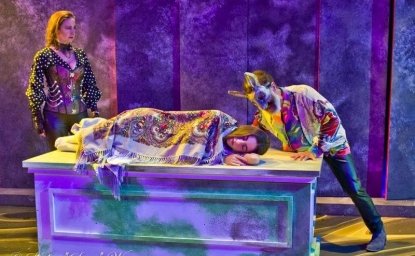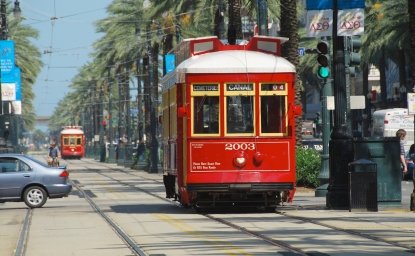A garage door dominates the cinderblock industrial storefront tucked onto Santa Rosa, California’s Sebastopol Avenue next door to the Criminal Baking Company and uncomfortably close to a major highway cloverleaf. Only a splash of purple paint and a seemingly handmade red sign suggest what lurks inside – an exciting scrappy theater company -- The Imaginists -- dedicated to art, activism and community, bringing theater to the disenfranchised and the disenfranchised to contemporary American theater. The word “scrappy” has been applied so often to the company by reviewers that the label amplifies how far contemporary theater has moved from daily life. For founders Brent Lindsay and Amy Pinto and their ensemble-driven company, using theater to reach out to day laborers, undocumented youth, immigrant rights groups and English-Spanish bilingual audiences is not so much “scrappy” as “normal.”
Santa Rosa, the county seat for the famed Sonoma Valley wine district, is itself at the “scrappy” intersection of upscale and hardscrabble. Long an agricultural center, Sonoma remained just far enough away to be outside of the stresses and strains of big city life in San Francisco, an hour or so away. Presently home to approximately 175,000 residents, Santa Rosa has become ever more diverse in recent years with over half of the population consisting of non-Hispanic whites; more than a quarter being Hispanic or Latino of any race, with the balance drawn from African Americans, Native Americans and a dozen or more immigrant communities. “Scrappy” rings true for the city and its internationally renowned theater company as much as the local Chamber of Commerce’s claim that their city is “California’s Cornucopia.”
Lindsay and Pinto launched the company with the goal of creating unintimidating theater, completely re-thinking theater who participates, where it happens and what it is. They create works that reflect the variety of voices all around them and to do so in a way that break down existing hierarchies within the theater and within the community. Ensemble, audiences and community blend together as The Imaginists regularly collaborate with local partners traditionally excluded from the stage. In doing so, they make no sacrifice in theatrical excellence.
Not only do their superbly innovative productions prompt Bay Area residents from San Francisco and Berkeley to travel an hour or more out of their comfort zones; they also take their shows on the road. Their productions regularly tour nationally and internationally, earning kudos as far away as Moscow. As important, their productions travel to local middle and high schools in low-income districts. Such works focus on real-life challenges for their audiences, such as the tale of a young undocumented person navigating the system to become a “real” boy. Beyond touring, Lindsay, Pinto and their associates participate in international exchanges with such leading companies as Hungarian Árpád Schilling’s cutting edge Kretakor. Such connections reach out within the United States and California as well, including an exchange with the Los Angeles-based Teatro Jornalero sin Fronteras.
The Imaginists were preceded by the Knights of Indulgence Theatre United States (KITUS), founded in 1993 by Pinto, Lindsay, and five other artist colleagues with the goal of moving theater beyond established bounds, conceived as a space in which individual voices would contribute to a shared understanding of community. By 2001, KITUS had grown into The Imaginists under the leadership of Pinto and Lindsay.
In keeping with their non-traditional inclusionary mission, Pinto and Lindsay encourage members to draw on their own stories and imaginations to write and produce performances that are unique. This goal has become embedded into the very production of plays, which begin by gathering the ensemble for each new work to contribute ideas, stories, images, writing, movement choreography and/or research as part of their unique collaborative process.
As the company notes in its website:
Often the lives of the collected ensemble bleed into the fabric of the made-up world of the performances we are making. We play with the layers of who we are and who we are pretending to be. We make theater of place and we include people from that place in our productions. Our process has grown out of many years of making theater with varied groups, from our actor-driven beginnings to young people, community members, emerging artists, artists across discipline, and hybrids of all of these—always impelled to include those who had never thought themselves performers.
In trying to describe how the company works, a member told an interviewer for The Oak Leaf News, “If other theaters are like farmers using the rich soil left by volcanic lava, this theater is a volcano.”
Under the hand of director Lindsay, a recent adaptation of Euripides’ The Trojan Women reimagined the surviving women of war-torn Troy as a tired band of veteran circus performers. Moving from shabby dressing room to worn-out circus ring, the women reenacted their tragic life stories and continuing battles to become the twenty-first century WarCircus. As Helen emerges from a giant steaming egg, Euripides becomes as contemporary as the iPhones carried by audience members.
In SitCalm!, the Company deconstructs the American television sitcom with Pinto and Lindsay playing mom and dad. Described by KQED’s Senior Arts Editor Chloe Veltman as “a totally warped take on sitcom tropes,” the play draws on stereotypical teenagers from all the ethnicities, backgrounds and personalities found in Santa Rosa to deliver a sprawling dystopia about American family life and television culture.
Every summer, Company members take their show on the road with a “free, bilingual, bicycle-powered” tour on Santa Rosa’s public parks, day laborer centers and community centers. Beginning in 2001, they put their props, costumes and sets on their bikes and peddle off at sunset to nearby public settings. There, they set up an ever-evolving The Art is Medicine Show/El show el arte es medicina.
Moving easily between English and Spanish, the performers might draw from a classical text – such as Federico Garcia Lorca’s poetic drama The Butterfly’s Evil Spell/El Maleficio de la Maripoisa—or from some new inspiration drawn from the actors’ imaginations, such as a recent take on Prometheus Bound: Calderon’s Life is a Dream. They invite audience members on stage, or ask them to create an end to the story. Some performances include community potluck meals, while others are a brief interruption in a summer evening’s merriment.
While “scrappy” is often employed by critics to describe the production, audience members writing on Facebook may have gotten closer to the truth by describing the company as: “Inventive;” “Creative, Angry, Itchy, Under-the-skin irritating;” and, as “Brave. Fearless, Inclusive. Honest. Uplifting.” These characteristics led KQED Theater Critic John Wilkins to note that “Santa Rosa’s The Imaginists is the type of theater company you wish every city had, “deeply committed to community where they reside, yet full of a cosmopolitan dash and daring.”
Such comments underscore the company’s success at bringing together art, activism and community and taking it to the disenfranchised. By doing so Lindsay and Pinto are creating new audiences for contemporary theater and transforming contemporary theater in the process.
Once a visit to a park or a community center is over, the actors load up the assorted tools of their trade, climb back on their bicycles and peddle away. As they do so, they leave behind new connections between community and theater that are transforming both everyday life and art.
Artistic Visionaries and Community Creators
The power of the performing arts to nurture inclusive communities has been praised widely in recent years; so much so that “creative placemaking” is now seen as a powerful tool in community development. The supportive role of community in fostering artistic innovation is less acknowledged. This series highlights the work of visionaries for whom creating communities of students, protégés, audiences, and donors has become a strategic element in transforming their arts.
Author

Former Wilson Center Vice President for Programs (2014-2017); Director of the Comparative Urban Studies Program/Urban Sustainability Laboratory (1992-2017); Director of the Kennan Institute for Advanced Russian Studies (1989-2012) and Director of the Program on Global Sustainability and Resilience (2012-2014)

Urban Sustainability Laboratory
Since 1991, the Urban Sustainability Laboratory has advanced solutions to urban challenges—such as poverty, exclusion, insecurity, and environmental degradation—by promoting evidence-based research to support sustainable, equitable and peaceful cities. Read more

Explore More in Artistic Visionaries and Community Creators
Browse Artistic Visionaries and Community Creators
Mark and Susan Marie Rhea and Irish Theater

Hugo and Rebecca Medrano and Hispanic Theater

Andrew Kingsley, Andrew Vaught and Social Impact Theater


